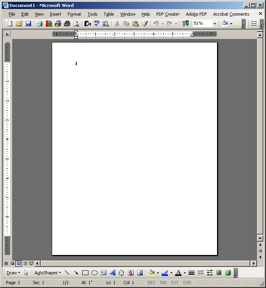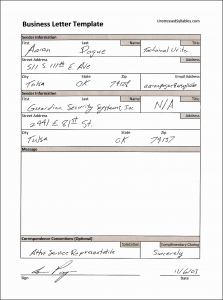Between my About page, my introductory article, and just the name of the website, I’ve already made a lot of big promises. Turning Technical Writing into a simple, stress-free task is no small feat, but we’re going to get started right now.
While reading that introductory material, you may have noticed that I referred to Technical Writing more than once as “filling in the blanks.” When you know what you’re doing, that’s all it needs to be. I’ve heard students and engineers and writers alike complain about how intimidating the blank page is. I’ve been there, too. Somewhere along the way, though, I realized that there are no blank pages. Not in Technical Writing, and not in Creative Writing, either. Maybe there’s a blank line, maybe there’s a blank box that needs a few paragraphs of text, but by the time you start working on a project, there’s no blank page.
Creative Writers handle this with prewriting (a topic I’ll discuss at length in other articles). If you wanted to write a short story or a novel, but found yourself overwhelmed by the blank page, you could address that stress by creating a mock Table of Contents, figuring out a detailed character list, maybe even developing a full plot synopsis. Once you’ve got several of those together, you don’t have a blank page anymore. You have a title and a chapter number and a character name, and you know where you’re starting from, where you’re headed, and all you have to do is write down what happens along the way.
That’s still a lot of work, and I’ve never promised anywhere “Effortless Syllables.” In Tech Writing, too, you’ll have to work hard on researching technical details, expressing yourself clearly, and fixing any errors along the way. What I have promised (and will again), is that the process of expressing yourself clearly and fixing errors can become accessible and even natural to you. There aren’t any mysteries to it.

Business Letter Blank Page
Back to our blank page, though. I briefly outlined above how a Creative Writer solves the problem of a starting point, but for Technical Writers it’s even easier. Let’s say, as an example, that I find myself in a situation where I have to write a business letter. I open Microsoft Office (or OpenOffice.Org Writer, or even Google Docs), and what does that software throw at me? A blank page. Terrifying, right?
It doesn’t have to be. Not to a Technical Writer. Not to anyone with much experience writing business letters. I know from long experience that a business letter starts with a letterhead containing author-identifying information (most often a return address), then comes the date, then the inside address, and the body of the letter, and so on. I know the structure of a standard business letter, and once you know that, the blank page could just as easily be a form full of blanks.
I always fill in the easy stuff first. I’d start off with my letterhead and the date, then fake in as much as I know of the internal address, then add a salutation and skip down to the bottom to add my signature block. Hah! I’m 90% finished writing my business letter! I’ve filled in fifteen out of sixteen boxes, until the only one left is the one in the middle labeled “body” or “message.”

Standard Business Letter as a Form
And I can already hear you objecting that that’s the hard part! You’re right. It doesn’t need to be stressful or challenging or mysterious, but the message is the hard part of writing a business letter. It should be! The message is the unique information, and the process of organizing and communicating information is one of the noblest, most amazing things people do. Filling out that final box is, in a way, heroic.
The point of this article, though, is that you shouldn’t have to guess where to start. You shouldn’t have to fumble around with formatting and layout. Your sole focus should be on communication, on getting to your message and figuring out how to say it. Surprisingly enough, getting straight to the hard part actually makes your job easier.
It’s pretty simple to see how that works with business letters, because we’ve all read plenty of business letters in our lives. Most of us have even written a few. That same process that I went through applies to nearly all technical documents, though. We have certain familiar document types, certain repeated templates, that have become standard formats, and once you learn how a particular document type works you can open up a blank page and just dive right in. Once you learn the shape of a document, you can tell at a glance exactly what information goes where. Not only that, you can fill in the easy stuff right away, and know what’s missing.
That’s what’s so daunting about the blank page. It gives you no feedback. It gives you no reference. There’s no sense of where to start, or how much to say, or when to say it. A standard document template strips away all that guesswork, and leaves just one or two empty boxes where you have to write down what it is you know, that someone else needs to know. That last step is one I can never do for you.
The document types, though? Those are my specialty. I can teach you how to write a business letter in your sleep. I can teach you how to write a memo, how to make a new document type from scratch, and force it into the shape you need. I can teach you shortcuts, handy tips, and critical rules. I can even teach you the difference between “who” and “whom,” and how to keep “effect” and “affect” straight. All of that information is available, but before it does you any good, you have to find the courage to get started.
That’s my goal. That’s what this blog is for. There’s countless resources out there to teach you grammar rules, and limitless clever and beautiful templates available as free downloads, but none of those are any good until you know what your document is supposed to do. That’s what we’ll work on here.






teach me! I’ve begun doing this in some small ways in my blog entries. If I have a blog that’s part of a series I have my beginning and ending information about the series.
Also, I am increasingly creating drafts at a moment of inspiration. I write a title, and a list of one-liners that express in shorthand one thought for the post, creating somewhat of a template. Later on, when I’m ready to actually write the post it creates this kind of effect where it’s already a form and all I have to do is fill in the blanks.
I never thought of it quite like this. It gives me more impetus to really utilize this method as a strategy for writing posts effectively rather than just a way to get my thoughts down for later use.
That’s exactly the right way to look at it, Carlos. Too many writers worry their work will end up predictable and formulaic, and create enormous amounts of unnecessary effort for themselves.
I’ll write an entire article sometime explaining why that doesn’t have to be true — why the bit that makes your work special and unique is what goes in “the final box” (as I said above), not in the design of your form, but you’re on exactly the right track.
As far as business letters and memo type writing, I always start by filling in the easy stuff. It makes me feel like I’ve nearly completed the task. But I never thought of using that same technique for writing novels, short stories or even blogs. I can’t wait to use this in my own writing. Thanks for the helpful tips!
The effect of the blank page upon me is to intensify the panic-prone portion of my affect.
Oy!